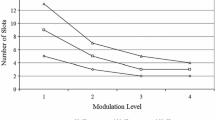Abstract
This paper studies algorithms for connection establishment in wavelength division multiplexing networks. Although wavelength conversion capabilities are assumed at each node in the network, the goal of this research is to minimize or impose an upper bound on the number of wavelength conversions on the established path. Two types of schemes are investigated and compared. In the first scheme, the wavelengths are selected adaptively during path establishment on a given route, and in the second scheme, both the route and the wavelength assignment are selected optimally based on global information about path costs and wavelength availability in the network. We present two efficient algorithms for globally selecting routes and wavelengths, one finds the least cost route for a maximum number of wavelength conversions, and the other selects from among the shortest routes, the one with a minimum number of wavelength conversions. The results of comparing the two path establishment schemes show that, for dynamically changing traffic, the adaptive selection of wavelengths on a fixed route during path establishment is more beneficial than the optimal selection of the route and wavelengths prior to path establishment.
Similar content being viewed by others
References
I. Gidon, R. Rom, Multi-path routing combined with resourcee reservation. IEEE INFOCOM'97, vol. 1, Kobe, Japan, (April 1997), pp. 92-100.
I. Chlamtac, A. Ganz, G. Karmi, Lightpath communications: an approach to high-bandwidth optical wans, IEEE Trans. on Communications, vol. 40,no. 7, (July 1992), pp. 1171-1182.
P. Dowd, K. Sivalingam, iA multi-level wdm access protocol for an optically interconnected parallel computer. IEEE INFOCOM'94, vol. 1, Toronto, Canada, (June 1994), pp. 400-408.
B. Mukherjee, D. Banerjee, S. Ramamurthy, A. Mukherjee, Some principles for designing wide area optical networks. IEEE/ACM Trans. on Networking, vol. 4,no. 5, (October 1996), pp. 684-696.
R. Barry, P. Humblet, Models of blocking probability in all-optical networks with and without wavelength changers. IEEE INFOCOM'95, vol. 2, Boston, MA, (April 1995), pp. 402-412.
E. Karasan, E. Ayanoglu, Effect of wavelength routing and selection algorithms on wavelength conversion gain in WDM optical networks. In IEEE/ACM Trans. on Networking, vol. 6,no. 2, (April 1998), pp. 186-196.
R. Pankaj, R. Gallager, Wavelength requirements of all-optical networks. IEEE/ACM Trans. on Networking, vol. 3,no. 3, (August 1995), 269-280.
B. Ramamurthy, B. Mukherjee, Wavelength conversion in WDM networking. In IEEE J. on Selected Areas in Communications, vol. 16,no. 7, (July 1998), pp. 1061-1073.
R. Ramaswami, A. Segall, Distributed network control for wavelength routed optical networks. In IEEE INFOCOM'96, San Francisco, CA, vol. 1, (March 1996), pp. 138-147.
I. Cidon, I. S. Gopal, A. Segall, Connection establishment in high-speed networks. IEEE/ACM Trans. on Networking, vol. 1,no. 4, (August 1993), pp. 469-482.
Awerbuch et al., Distributed control for Paris. In Proceedings of 9th Annual ACM Symp. on Principles of Distributed Computing, (1990), pp. 145-160.
C. Qiao, R. Melhem, Reconfiguration with time division multiplexing MINs for multiprocessor communications. IEEE Transactions on Parallel and Distributed Systems, vol. 5,no. 4, (April 1994), pp. 337-352.
X. Yuan, R. Melhem, R. Gupta, Distributed path reservation algorithms for multiplexed all-optical interconnection networks. In Proceedings of the IEEE Symp. High Performance Computer Architecture, San Antonio, TX, (Feb. 1997).
C. Qiao, Y. Mei, Wavelength reservation under distributed control. In IEEE/LEOS summer topical meeting: Broadband Optical Networks, (August 1996).
X. Yuan, R. Melhem, R. Gupta, Y. Mei, C. Qiao, Distributed control protocols for wavelength reservation and their performance evaluation. In Photonic Network Communications, vol. 1,no. 3, (Nov. 1999), pp. 207-218.
S. Subramaniam, M. Azizoglu, A. K. Somani, Connectivity and sparse wavelength conversion in wavelength-routing networks. In IEEE INFOCOM'96, San Francisco, CA, vol. 1, (March 1996), pp. 148-155.
Chlamtac, A. Farago, T. Zhang, Lightpath (wavelength) routing in large WDM networks. IEEE J. on Selected Areas in Communications, vol. 14,no. 5, (May 1996), pp. 909-913.
V. Kompella, J. Pasquale, G. Polyzos, Multicast routing for multimedia communication, In IEEE/ACM Trans. on Networking, vol. 1,no. 3, (June 1993), pp. 286-292.
V. Sharma, E. Varvarigos, Limited wavelength translation in all-optical WDM networks. INFOCOM'98, San Francisco, CA, vol. 1, (March/April 1998).
Author information
Authors and Affiliations
Rights and permissions
About this article
Cite this article
Melhem, R., Li, S. & Znati, T. Minimizing Wavelength Conversions in WDM Path Establishment*. Photonic Network Communications 3, 197–211 (2001). https://doi.org/10.1023/A:1011490929017
Issue Date:
DOI: https://doi.org/10.1023/A:1011490929017




